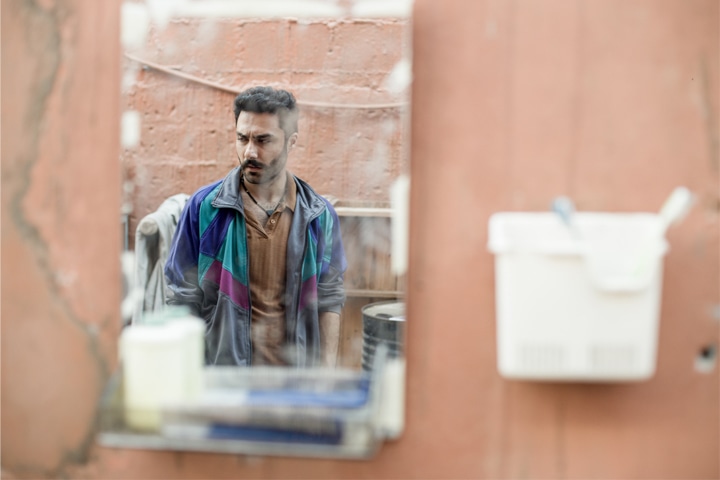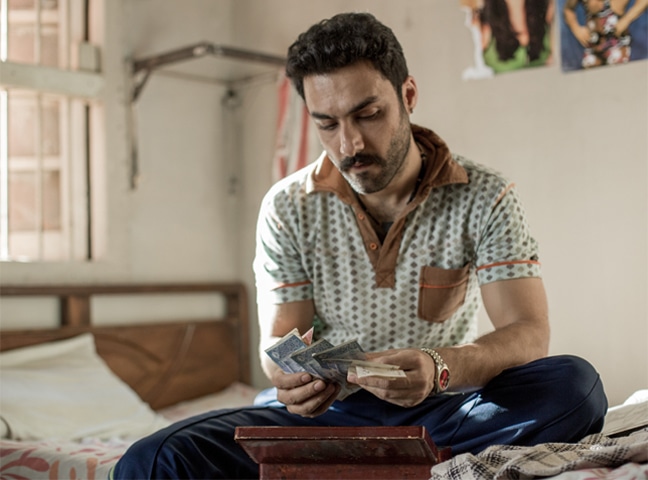Even though I was an hour late, I feel I was still too early as I enter the 14th floor apartment with a small chalked blackboard that read ‘Laal Kabootar Meeting’.
Entering the unfussily decorated space, I wave at a journalist friend who was in the midst of her interview with the film’s lead pair, Mansha Pasha and Ahmed Ali Akbar. At their backs, a full-sized rendition of the film’s title is oil-painted on the wall. The room is big, yet negligibly furnished, with only three small chairs and a poster of the film on a wall in the middle of the room.
One corridor to the left, a small adjacent office space, is set up as a makeshift waiting area. A copy of Notes on Directing is deliberately laid on a tabletop near a small sofa; its pages yellowing and deliciously acidic (if you haven’t smelled or nibbled a good old book, you don’t know what you’re missing). A whiteboard with the film’s shot-list in coloured markers stands partially hidden behind a table. A paperback of the Girl with the Dragon Tattoo rests on top of three other books in the top-shelf of an open rack. These small, deliberately placed details fill in a lot of answers. I may be talking to a smart bunch who may know what they are talking about.
The audience has high hopes from director Kamal Khan’s debut feature Laal Kabootar, lined up for release on March 22. Icon finds out what sets the film apart from this year’s other scheduled releases
The apartment belongs to producers Hania and Kamil Chima, a Harvard-educated brother-sister duo who, inexplicably, pursued filmmaking. Their first film, Laal Kabootar, a thriller, is due out on the 22nd of this month.
“It’s a desi, murder mystery, crime drama — an entry into Karachi’s darker side,” Kamil tells me as we start the interview.

“That still doesn’t tell me anything about the film,” I say.
We laugh, as if that has really answered my question about the story.
Opposite me sit Akbar, Pasha, and the two producers. Director Kamal Khan is out of Pakistan.
Thrillers are a tricky genre, I tell them. The only moderately successful example I can think of was Jalaibee — a stylistic-made crime story that was all over the place storytelling-wise.
As if things weren’t risky enough, Laal Kabootar recently debuted a Red Band trailer, where expletives run hand-in-hand with subtle insinuations. In one shot, Akbar’s character is seen lying in bed with a woman.
“I don’t think the two characters were married,” I ask?
The right casting also made a world of a difference in shaping the story, I’m told. “When the actors came in, the black-and-white turned to technicolor. When Ahmed auditioned, we literally saw the film take life,” Kamil adds. Unlike other film actors, Ahmed auditioned for the role, despite knowing Kamal for the past few years.
“We’ve cut some elements of the film down, and bleeped swearwords,” says Kamil, explaining that the Sindh Board of Film Censors gave them an unrestricted rating.
By unrestricted, I am assuming a PG-13 (or equivalent rating). Anything higher, and the film loses a bigger chunk of its business. In an environment where footfalls are already lower than usual, releasing a niche genre film is a risky enough decision as it is.
“You don’t have to be too explicit to be explicit,” says Pasha. “It’s there, but it’s too nuanced to be immediately noticeable.”
Kamil and Hania didn’t start the project with the intention of it being too brainy for the masses. “When we were starting off, laying the foundation, we asked ourselves this: if we look back at the last 100 years of cinema, what would be the one thing that is most marketable, or sure-shot sellable to the audience,” Kamil asks.

“Is it CGI, which is a recent invention? Colour grading? No. The answer is: a good story. So, we chased down the story. To make it the best it can be. We didn’t care whether my ego was being hurt, or that ideas were being rejected. Whatever it took, we were open to it. We wanted to tell this story the best way it can be told.”
Apart from Ali Abbas Naqvi, the screenwriter, the producers had set up a writer’s table, I’m told.
“I think this film’s development was an evolutionary process,” Kamil continues. “It started when Hania and I came up with the concept, which we brought to Kamal, who took it in a completely different direction. Then we brought in writers, and each new writer would bring their own flavor.”
The storytelling wasn’t a piece of cake, I’m led to believe. “Every now and then we would hit a wall,” Kamil explained. “For example, we were mostly men writing a female character — Mansha’s character. I realised, that, say, if we were writing an action scene between two men, I would unconsciously have the female character stand on the other side of the room, scared. This wouldn’t be right. I haven’t seen a single woman who would do that. If we had a man in that scene, and not a woman, would he be standing scared like the woman?” he asks.
The right casting also made a world of a difference in shaping the story, I’m told. “When the actors came in, the black-and-white turned to technicolor. When Ahmed auditioned, we literally saw the film take life,” Kamil adds. Unlike other film actors, Ahmed auditioned for the role, despite knowing Kamal for the past few years.
“I believe in auditions,” Ahmed says. “It’s healthy for the industry and it’s good for the actor. It lets you know where you stand. It keeps you grounded.
As far as Pakistani cinema is concerned, everybody wants to make things look pretty, and we’re running into the opposite direction,” says Pasha. “So, we made it look as grungy as possible. Sometimes, Kamal came to me and said, you look pretty. Often he would be kum karo apna make-up [tone down your make-up], it shouldn’t look like we’re trying to make you look pretty.”
“I was actually rejected for the parts I auditioned for,” Ahmed says. “An established actor wouldn’t be saying that out loud, but when I saw the film, I was like, sahi kara, bilkul theek tha [they were right in not choosing me] — I didn’t fit that role.”

“His audition started when he opened the gate, he was instantly in character,” says Hania. It was, apparently, an amusing experience — one they have contemplated about releasing as a blooper reel once the film comes out.
“Kamal actually stifled a laugh when I came in,” Ahmed fills in, “but he didn’t cut.
“There are so many things you add to the character as the actor and character evolve from paper,” Ahmed says of his journey with the character. “Whether it’s the addition of a baali [earring], or the sort of shoes you wear, the moustache, or the jacket, or the walk. Things get plugged in that contribute to the overall personality.”
Unlike Ahmed, Pasha hadn’t met Kamal before she was contacted for the role, but she did know of him. “I had seen a music video of his, and felt that this man was a visionary.”
Pasha is referring to The Desert Journey by the music band D/A Method, which came out in 2016; the seven-minute single-take music video was more or less a showcase of the director and his team (Naqvi, was, again, the screenwriter and assistant director, and Mo Azmi, Laal Kabootar’s DoP, also shot that video). The video starred her friend, Suhaee Abro, recalls Pasha, saying she was a bit jealous of Abro at the time.

“When Kamal called me up for Laal Kabootar, I instantly asked: ‘What’s the role?’ ” she laughs. She plays a desperate woman caught in desperate circumstances.
“Personally, whenever I tried to play it safe, I’d fail. Whenever I threw myself in the deep end, even in my personal life, I’d come out on top,” Pasha tells me.
She was smitten by the story in an instant. “When girls start a relationship, they immediately start planning the wedding. That happens to me at work. I begin imagining that I’m at the premiere.”
Without giving anything away, I’m told that the script was amended during production. “In fact, it was being amended right down to when we were editing. The story didn’t change, but the order of scenes did,” Hania explains. “It’s not as much about the scenes as it is about the delivery,” interjects Pasha. “Even within one scene, the way you say every line will change the meaning of the scene.”
Pasha elucidates her point by saying ‘Kya kar rahay ho?’ [What are you doing?] in three variants, in a single breath.
“After rehearsing a scene six times, when we would come to set the next day, the delivery would change completely. ‘You’re not doing that anymore’, Kamal would say. ‘Aisa to karna hi nahi hai [That’s not how it’s supposed to be at all]’, and I would have to completely realign myself to the situation.”
Even though Kamal wasn’t in the room, the ensuing conversation with the actors is more insightful about the director than a one-on-one interview with him.
“There is a scene where I would get smacked across the face,” Ahmed recalls. “Without telling me, Kamal tells the other actor to hit me as hard as he can, and my face literally spun towards the camera. The reaction I gave was genuine.”
Was Kamal dependent on Mo Azmi (the cinematographer), I enquire? The cinematographer, whose credits include O21 and Cake is notorious for his resoluteness on set.
“It depended on the scene”, Ahmed fills in. “After we would fine-tune the scene, Kamal would bring in Mo Azmi and ask him how he would shoot it.”
“Mo would see what you’re wearing, and then change the lighting [or maybe] break the outfit by suggesting additions, such as wearing a scarf,” Pasha interjects.

Often a cinematographer is responsible for the look-development of a film. Isn’t Laal Kabootar’s red colour grade a bit too clichéd, I ask? The palette bears an uncanny similarity to Cake and The Desert Journey. Kamil tells me that the final grade isn’t finished yet. However, he tells me that the murky tone has a philosophy behind it. “The moment you enter the cinema, we want you to be completely immersed in that world and with the characters. You should believe that Ahmed is not Ahmed. He is the guy who is desperate. He wants to escape. And you should connect to that plight. There should be no distraction from that. We chose to go to the underbelly, seeking character. So, even within the city, we tried to make those particular choices.”
“As far as Pakistani cinema is concerned, everybody wants to make things look pretty, and we’re running in the opposite direction,” says Pasha. “So, we made it look as grungy as possible. Sometimes, Kamal came to me and said, you look pretty — and I was like, ‘Thank you Kamal. Aik scene mein acchi lag rahi hoon [I, at least, look beautiful in one scene]’. Often he would be ‘Kum karo apna make-up [Tone down your make-up], it shouldn’t look like we’re trying to make you look pretty.’
“You would see each and every pore in our faces. There is no airbrushing — my nostrils look more flared than usual,” she says, pointing at the big poster behind her.
Looking at the everyday shalwar kameez her character wears in the poster, I suppose they saved a lot on costume design. “It’s more expensive to dress down,” Hania replies. “You have to buy new clothes, but then you would make it look old by throwing dirt on it.”
Getting the topic back on track, Ahmed says that the production design plays a vital role in the production. “You would see my character’s background by looking at where he lives. You might not immediately pick it up, but there is thought put in it,” he says. “You’ll see his history with the props that are in the scene. With the posters. Things that might not be revealed to the audience. The sewing machine that we placed in the corner has history. The film doesn’t show his mum, so the sewing machine alludes to the fact that she used to sew clothes for a living. The picture he picks up in one shot has a story. You might not even see who the picture is of,” he explains of the film’s ambiguity.
“Things like the picture aren’t relevant to the audience, but they are for the character,” Kamil says.
At that moment, I recall the room I was waiting in before the interview. Of things placed round the room which, subconsciously, tell you everything without giving anything away.
Published in Dawn, ICON, March 17th, 2019
















































Dear visitor, the comments section is undergoing an overhaul and will return soon.